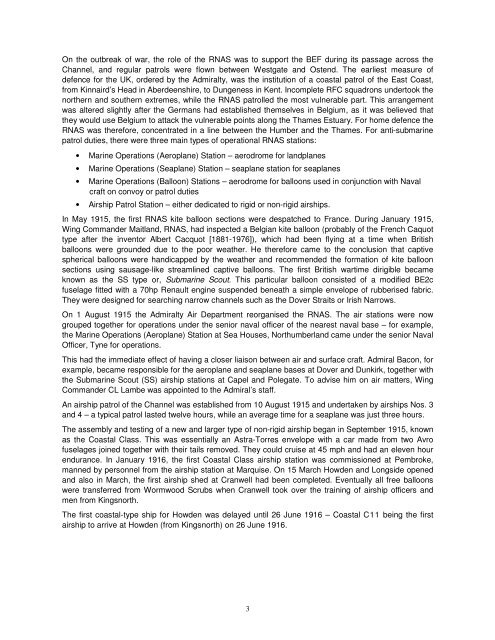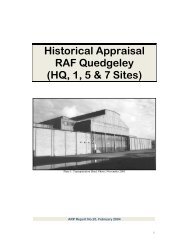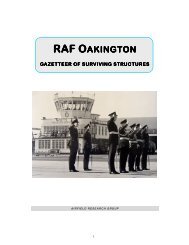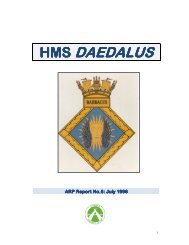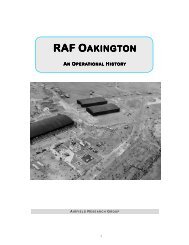RNAS Howden - The Airfield Research Group
RNAS Howden - The Airfield Research Group
RNAS Howden - The Airfield Research Group
You also want an ePaper? Increase the reach of your titles
YUMPU automatically turns print PDFs into web optimized ePapers that Google loves.
On the outbreak of war, the role of the <strong>RNAS</strong> was to support the BEF during its passage across the<br />
Channel, and regular patrols were flown between Westgate and Ostend. <strong>The</strong> earliest measure of<br />
defence for the UK, ordered by the Admiralty, was the institution of a coastal patrol of the East Coast,<br />
from Kinnaird’s Head in Aberdeenshire, to Dungeness in Kent. Incomplete RFC squadrons undertook the<br />
northern and southern extremes, while the <strong>RNAS</strong> patrolled the most vulnerable part. This arrangement<br />
was altered slightly after the Germans had established themselves in Belgium, as it was believed that<br />
they would use Belgium to attack the vulnerable points along the Thames Estuary. For home defence the<br />
<strong>RNAS</strong> was therefore, concentrated in a line between the Humber and the Thames. For anti-submarine<br />
patrol duties, there were three main types of operational <strong>RNAS</strong> stations:<br />
• Marine Operations (Aeroplane) Station – aerodrome for landplanes<br />
• Marine Operations (Seaplane) Station – seaplane station for seaplanes<br />
• Marine Operations (Balloon) Stations – aerodrome for balloons used in conjunction with Naval<br />
craft on convoy or patrol duties<br />
• Airship Patrol Station – either dedicated to rigid or non-rigid airships.<br />
In May 1915, the first <strong>RNAS</strong> kite balloon sections were despatched to France. During January 1915,<br />
Wing Commander Maitland, <strong>RNAS</strong>, had inspected a Belgian kite balloon (probably of the French Caquot<br />
type after the inventor Albert Cacquot [1881-1976]), which had been flying at a time when British<br />
balloons were grounded due to the poor weather. He therefore came to the conclusion that captive<br />
spherical balloons were handicapped by the weather and recommended the formation of kite balloon<br />
sections using sausage-like streamlined captive balloons. <strong>The</strong> first British wartime dirigible became<br />
known as the SS type or, Submarine Scout. This particular balloon consisted of a modified BE2c<br />
fuselage fitted with a 70hp Renault engine suspended beneath a simple envelope of rubberised fabric.<br />
<strong>The</strong>y were designed for searching narrow channels such as the Dover Straits or Irish Narrows.<br />
On 1 August 1915 the Admiralty Air Department reorganised the <strong>RNAS</strong>. <strong>The</strong> air stations were now<br />
grouped together for operations under the senior naval officer of the nearest naval base – for example,<br />
the Marine Operations (Aeroplane) Station at Sea Houses, Northumberland came under the senior Naval<br />
Officer, Tyne for operations.<br />
This had the immediate effect of having a closer liaison between air and surface craft. Admiral Bacon, for<br />
example, became responsible for the aeroplane and seaplane bases at Dover and Dunkirk, together with<br />
the Submarine Scout (SS) airship stations at Capel and Polegate. To advise him on air matters, Wing<br />
Commander CL Lambe was appointed to the Admiral’s staff.<br />
An airship patrol of the Channel was established from 10 August 1915 and undertaken by airships Nos. 3<br />
and 4 – a typical patrol lasted twelve hours, while an average time for a seaplane was just three hours.<br />
<strong>The</strong> assembly and testing of a new and larger type of non-rigid airship began in September 1915, known<br />
as the Coastal Class. This was essentially an Astra-Torres envelope with a car made from two Avro<br />
fuselages joined together with their tails removed. <strong>The</strong>y could cruise at 45 mph and had an eleven hour<br />
endurance. In January 1916, the first Coastal Class airship station was commissioned at Pembroke,<br />
manned by personnel from the airship station at Marquise. On 15 March <strong>Howden</strong> and Longside opened<br />
and also in March, the first airship shed at Cranwell had been completed. Eventually all free balloons<br />
were transferred from Wormwood Scrubs when Cranwell took over the training of airship officers and<br />
men from Kingsnorth.<br />
<strong>The</strong> first coastal-type ship for <strong>Howden</strong> was delayed until 26 June 1916 – Coastal C11 being the first<br />
airship to arrive at <strong>Howden</strong> (from Kingsnorth) on 26 June 1916.<br />
3


